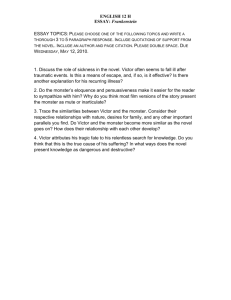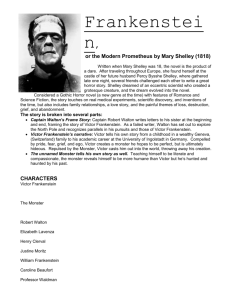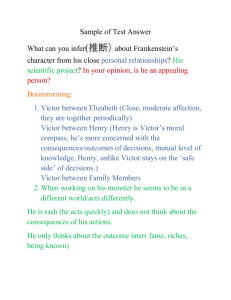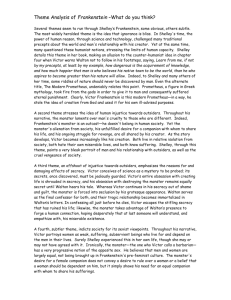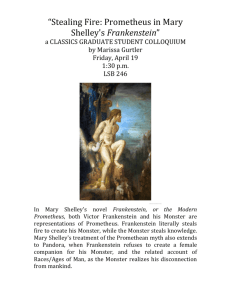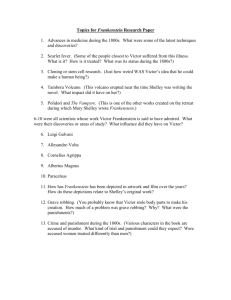Frankenstein Key Notes and Themes
advertisement
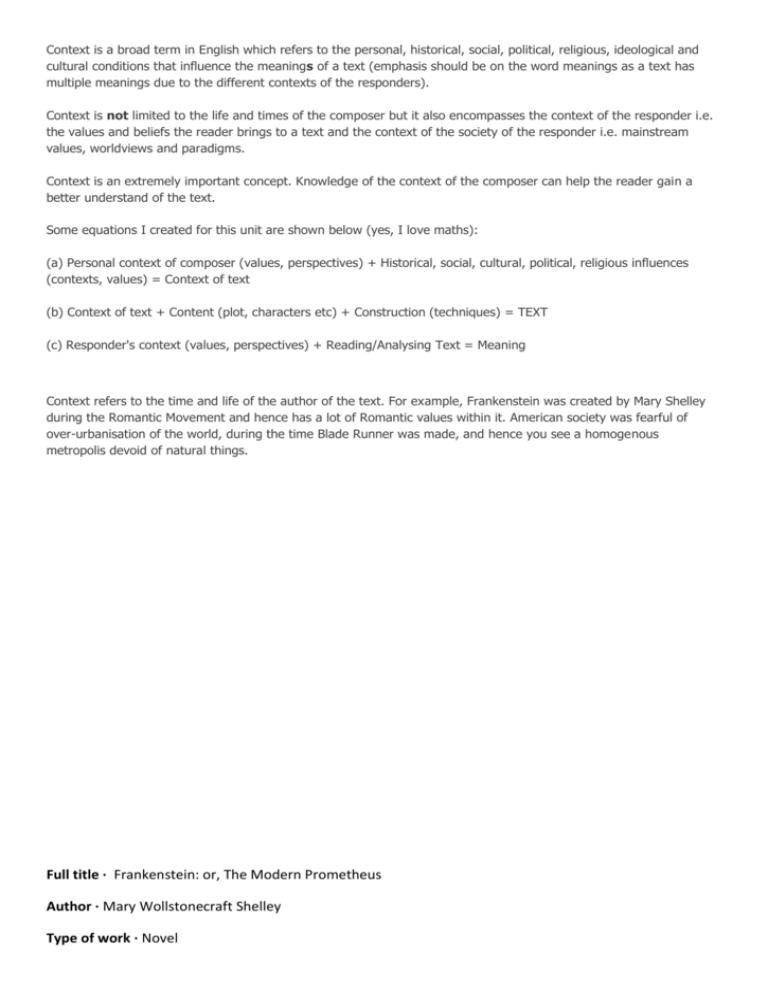
Context is a broad term in English which refers to the personal, historical, social, political, religious, ideological and cultural conditions that influence the meanings of a text (emphasis should be on the word meanings as a text has multiple meanings due to the different contexts of the responders). Context is not limited to the life and times of the composer but it also encompasses the context of the responder i.e. the values and beliefs the reader brings to a text and the context of the society of the responder i.e. mainstream values, worldviews and paradigms. Context is an extremely important concept. Knowledge of the context of the composer can help the reader gain a better understand of the text. Some equations I created for this unit are shown below (yes, I love maths): (a) Personal context of composer (values, perspectives) + Historical, social, cultural, political, religious influences (contexts, values) = Context of text (b) Context of text + Content (plot, characters etc) + Construction (techniques) = TEXT (c) Responder's context (values, perspectives) + Reading/Analysing Text = Meaning Context refers to the time and life of the author of the text. For example, Frankenstein was created by Mary Shelley during the Romantic Movement and hence has a lot of Romantic values within it. American society was fearful of over-urbanisation of the world, during the time Blade Runner was made, and hence you see a homogenous metropolis devoid of natural things. Full title · Frankenstein: or, The Modern Prometheus Author · Mary Wollstonecraft Shelley Type of work · Novel Genre · Gothic science fiction Language · English Time and place written · Switzerland, 1816, and London, 1816–1817 Date of first publication · January 1, 1818 Publisher · Lackington, Hughes, Harding, Mavor, & Jones Narrator · The primary narrator is Robert Walton, who, in his letters, quotes Victor Frankenstein’s firstperson narrative at length; Victor, in turn, quotes the monster’s first-person narrative; in addition, the lesser characters Elizabeth Lavenza and Alphonse Frankenstein narrate parts of the story through their letters to Victor. Climax · The murder of Elizabeth Lavenza on the night of her wedding to Victor Frankenstein in Chapter 23 Protagonist · Victor Frankenstein Antagonist · Frankenstein’s monster Setting (time) · Eighteenth century Setting (place) · Geneva; the Swiss Alps; Ingolstadt; England and Scotland; the northern ice Point of view · The point of view shifts with the narration, from Robert Walton to Victor Frankenstein to Frankenstein’s monster, then back to Walton, with a few digressions in the form of letters from Elizabeth Lavenza and Alphonse Frankenstein. Falling action · After the murder of Elizabeth Lavenza, when Victor Frankenstein chases the monster to the northern ice, is rescued by Robert Walton, narrates his story, and dies. Tense · Past Foreshadowing · Ubiquitous—throughout his narrative, Victor uses words such as “fate” and “omen” to hint at the tragedy that has befallen him; additionally, he occasionally pauses in his recounting to collect himself in the face of frightening memories. Tone · Gothic, Romantic, emotional, tragic, fatalistic. Themes · Dangerous knowledge; sublime nature; texts; secrecy; monstrosity Motifs · Passive women; abortion Symbols · Fire and light Themes in Frankenstein Themes are the fundamental and often universal ideas explored in a literary work. Dangerous Knowledge The pursuit of knowledge is at the heart of Frankenstein, as Victor attempts to surge beyond accepted human limits and access the secret of life. Likewise, Robert Walton attempts to surpass previous human explorations by endeavoring to reach the North Pole. This ruthless pursuit of knowledge, of the light (see “Light and Fire”), proves dangerous, as Victor’s act of creation eventually results in the destruction of everyone dear to him, and Walton finds himself perilously trapped between sheets of ice. Whereas Victor’s obsessive hatred of the monster drives him to his death, Walton ultimately pulls back from his treacherous mission, having learned from Victor’s example how destructive the thirst for knowledge can be. Sublime Nature The sublime natural world, embraced by Romanticism (late eighteenth century to mid-nineteenth century) as a source of unrestrained emotional experience for the individual, initially offers characters the possibility of spiritual renewal. Mired in depression and remorse after the deaths of William and Justine, for which he feels responsible, Victor heads to the mountains to lift his spirits. Likewise, after a hellish winter of cold and abandonment, the monster feels his heart lighten as spring arrives. The influence of nature on mood is evident throughout the novel, but for Victor, the natural world’s power to console him wanes when he realizes that the monster will haunt him no matter where he goes. By the end, as Victor chases the monster obsessively, nature, in the form of the Arctic desert, functions simply as the symbolic backdrop for his primal struggle against the monster. Monstrosity Obviously, this theme pervades the entire novel, as the monster lies at the center of the action. Eight feet tall and hideously ugly, the monster is rejected by society. However, his monstrosity results not only from his grotesque appearance but also from the unnatural manner of his creation, which involves the secretive animation of a mix of stolen body parts and strange chemicals. He is a product not of collaborative scientific effort but of dark, supernatural workings. The monster is only the most literal of a number of monstrous entities in the novel, including the knowledge that Victor used to create the monster (see “Dangerous Knowledge”). One can argue that Victor himself is a kind of monster, as his ambition, secrecy, and selfishness alienate him from human society. Ordinary on the outside, he may be the true “monster” inside, as he is eventually consumed by an obsessive hatred of his creation. Finally, many critics have described the novel itself as monstrous, a stitched-together combination of different voices, texts, and tenses (see Texts). Secrecy Victor conceives of science as a mystery to be probed; its secrets, once discovered, must be jealously guarded. He considers M. Krempe, the natural philosopher he meets at Ingolstadt, a model scientist: “an uncouth man, but deeply imbued in the secrets of his science.” Victor’s entire obsession with creating life is shrouded in secrecy, and his obsession with destroying the monster remains equally secret until Walton hears his tale. Whereas Victor continues in his secrecy out of shame and guilt, the monster is forced into seclusion by his grotesque appearance. Walton serves as the final confessor for both, and their tragic relationship becomes immortalized in Walton’s letters. In confessing all just before he dies, Victor escapes the stifling secrecy that has ruined his life; likewise, the monster takes advantage of Walton’s presence to forge a human connection, hoping desperately that at last someone will understand, and empathize with, his miserable existence. Texts Frankenstein is overflowing with texts: letters, notes, journals, inscriptions, and books fill the novel, sometimes nestled inside each other, other times simply alluded to or quoted. Walton’s letters envelop the entire tale; Victor’s story fits inside Walton’s letters; the monster’s story fits inside Victor’s; and the love story of Felix and Safie and references to Paradise Lost fit inside the monster’s story. This profusion of texts is an important aspect of the narrative structure, as the various writings serve as concrete manifestations of characters’ attitudes and emotions. Language plays an enormous role in the monster’s development. By hearing and watching the peasants, the monster learns to speak and read, which enables him to understand the manner of his creation, as described in Victor’s journal. He later leaves notes for Victor along the chase into the northern ice, inscribing words in trees and on rocks, turning nature itself into a writing surface. Motifs Motifs are recurring structures, contrasts, and literary devices that can help to develop and inform the text’s major themes. Passive Women For a novel written by the daughter of an important feminist, Frankenstein is strikingly devoid of strong female characters. The novel is littered with passive women who suffer calmly and then expire: Caroline Beaufort is a selfsacrificing mother who dies taking care of her adopted daughter; Justine is executed for murder, despite her innocence; the creation of the female monster is aborted by Victor because he fears being unable to control her actions once she is animated; Elizabeth waits, impatient but helpless, for Victor to return to her, and she is eventually murdered by the monster. One can argue that Shelley renders her female characters so passive and subjects them to such ill treatment in order to call attention to the obsessive and destructive behavior that Victor and the monster exhibit. Abortion The motif of abortion recurs as both Victor and the monster express their sense of the monster’s hideousness. About first seeing his creation, Victor says: “When I thought of him, I gnashed my teeth, my eyes became inflamed, and I ardently wished to extinguish that life which I had so thoughtlessly made.” The monster feels a similar disgust for himself: “I, the miserable and the abandoned, am an abortion, to be spurned at, and kicked, and trampled on.” Both lament the monster’s existence and wish that Victor had never engaged in his act of creation. The motif appears also in regard to Victor’s other pursuits. When Victor destroys his work on a female monster, he literally aborts his act of creation, preventing the female monster from coming alive. Figurative abortion materializes in Victor’s description of natural philosophy: “I at once gave up my former occupations; set down natural history and all its progeny as a deformed and abortive creation; and entertained the greatest disdain for a would-be science, which could never even step within the threshold of real knowledge.” As with the monster, Victor becomes dissatisfied with natural philosophy and shuns it not only as unhelpful but also as intellectually grotesque. Symbols Symbols are objects, characters, figures, and colors used to represent abstract ideas or concepts. Light and Fire “What could not be expected in the country of eternal light?” asks Walton, displaying a faith in, and optimism about, science. In Frankenstein, light symbolizes knowledge, discovery, and enlightenment. The natural world is a place of dark secrets, hidden passages, and unknown mechanisms; the goal of the scientist is then to reach light. The dangerous and more powerful cousin of light is fire. The monster’s first experience with a still-smoldering flame reveals the dual nature of fire: he discovers excitedly that it creates light in the darkness of the night, but also that it harms him when he touches it. The presence of fire in the text also brings to mind the full title of Shelley’s novel, Frankenstein: or, The Modern Prometheus. The Greek god Prometheus gave the knowledge of fire to humanity and was then severely punished for it. Victor, attempting to become a modern Prometheus, is certainly punished, but unlike fire, his “gift” to humanity— knowledge of the secret of life—remains a secret
